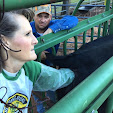This week has been a busy week in preparing for the pouring of the slab. There are several techniques that could be used when choosing a slab foundation. They could use fiber in the concrete, rebar, monolithic, stem wall... I think the options are endless. We chose a Post-Tension Slab. This type of slab is used mostly in areas where soil expands and contracts relative to weather conditions. Our property is in a sandstone area. Our winters can be cold and wet, with our summers being hot and dry. Currently we are in extreme drought conditions and we have had several earthquakes over the past year or so. The builder tells us, our site is a good location to use the post-tension. I don't want carpet in the house and plan to have stained concrete floors, so cracks CAN NOT happen. (My requirement!) The builder assures us, we will not have cracks.
A barrier is laid over the sand. This looks like a swimming pool liner. It is a think rubber.
Before the post-tension slab is poured, high-strength cables are laid in a grid.
These cables help support and give strength to the slab once it has cured. Extra care is taken to make sure the cables remain at the correct depth while pouring the slab.
Once the slab is poured, it is allowed to cure to about 75%. This will take about a week.
At this point the post-tensioning will occur. Each of the cables will be pulled tight, using a hydraulic jack.
The cables will be pulled to a tension of 25,000 pounds per square inch!
This morning, we were awaken by the pounding of the crew. They were forming up the utility and mud room forms.
We will be using paver bricks as our flooring in this area, so the slab needs to be recessed.
By 7:15am the concrete trucks had arrived.
By the time I left for work, 3 more trucks were waiting to unload.
I can't wait to get home!











No comments:
Post a Comment